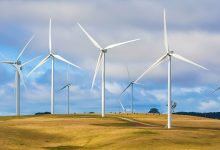An Australian invention, described as a ‘stethoscope for wind turbines’ could save the wind power industry up to $500 million in maintenance costs, is now ready to hit the export market.
The Ping Monitor, developed by South Australian firm Ping Services, is able to monitor the performance of wind turbines and identify the early development of potentially damaging physical faults in turbine blades.
The Ping Monitor is attached magnetically to wind turbine towers, and “listens” to the sounds created within the turbine as it operates, just like a stethoscope.
Using complex algorithms developed by Ping Services, the monitor is able to identify changes in the acoustic sounds created by the turbine’s operation, which may indicate damage or other changes to the turbine’s structures.
When the device detects an anomaly in a turbine’s operation, maintenance crews are provided with an alert via a dashboard, shortening the time it may take for damage to a turbine to be detected and allowing crews to undertake repairs before more costly damage is caused.
The inventors of the technology believe it could cut maintenance and repair costs in the wind power sector by as much as $500 million a year.
The monitor is currently able to provide an indication of the amount of damage that may have developed within a turbine blade, but CEO Matt Stead told RenewEconomy that the company believes that more detail can be extracted from the noise single, including specifying which particular turbine blade has suffered damage, and where along the blade the damage has occurred.
An earlier version of the Ping Monitor had operated as a ‘bespoke’ solution for individual wind farm projects and required a lot of hands on operation. However, the company has launched the next generation version of the monitor, which includes a self-contained power supply and communications equipment, allowing for standalone operation.
The device also allows for continuous monitoring of wind turbine condition, something that is currently done intermittently through drone inspections, that may be conducted months, or years, apart.
The development of a ‘mass-market’ version of the technology has now been completed, and after being field tested for more than 12 months, Ping is now looking for export opportunities to deploy the fault detection device at large-scale.
“If we got an order for 1,000 second-gen Ping Monitors tomorrow, we could fill it,” CEO Matthew Stead said.
“Until today, we have been working with our customers on a bespoke level. With the second-generation Ping Monitor, we are ready to manufacture and export at commercial scale.”
The company has already received interest from two wind farm operators in the United States, and will soon undertake its first large-scale deployments of the second generation Ping Monitor.
The Ping Monitor has been developed by company CEO Matt Stead, and CTO Jon Cooper, two acoustics experts, after being told that wind turbine technicians often knew that a wind turbine had suffered damage because it sounded different while operating.
The technology was subsequently developed with the assistance of a start-up grant provided by the South Australian government, under the Research, Commercialisation and Startup Fund, and the company successfully raised $1.3 million in seed funding from early investors, including Australian venture capital fund Artesian.
South Australian minister for skills and industry, David Pisoni, welcomed the company moving into the next stage of commercialisation.
“The Marshall Government supports South Australian innovation and manufacturing through the Research, Commercialisation and Startup Fund,” Pisoni said. “The Marshall Government’s investment in Matthew and Jon’s technology will now see the commercial development of this revolutionary one-of-a-kind product exported to the world.”
The Ping Monitor has already been deployed at a number of Australian wind farms, as well as projects overseas, and can be adapted for use in other large infrastructure projects, including in the resources, manufacturing and heavy transport sectors.
CEO Matt Stead said that it was encouraging to see the level of interest in the monitoring device from the wind industry.
“People have been keen to talk to us and understand what we have been up to. The industry has been open to thinking about these kinds of innovations, and its good to see the industry looking to improve its way of doing things and lowering costs,” Stead said.










